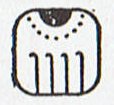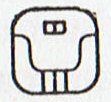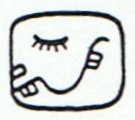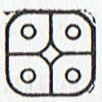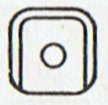|
TRANSLATIONS
The trees down on earth are soft and pliant as 'babies', when growing they become firm, and when 'completely dried out' (pakapaka) they will be easy to brake. This equation therefore - if valid - therefore cannot be visualizing the process of moai (heads bending down after 'noon'):
What it can visualize is how the 'skull' of the 'chief' is hung up to dry. The 'head' of the straight hakaturou sky propper is put on top while the rest of his body has disappeared (under ground). The 'body' of the 'fishhook' hakaturou is the pliant haga rave. The 'a.m. fish' is hung up to dry under the roof. I searched via Internet for clues as regards the meaning of paua in pauatun (the 4 Chacs). There is a Swahili word paua which means 'roof'. Combining this piece of information with the Polynesian paua (empty shells) it seems probable that paua does not mean '4' (other than implicitly). Instead paua presumably means the 'roof' (half of the giant clam). The 'roof', as conceptualized north of the equator, ought to lie in the 'north' (in not only in time but also in space). The wind (ehecatl) dries up, and then the skull can be lifted high in the new 'house' (calli). An when the 'house' is ready also a lizard (cuetzpallin) moves in: ... Ure set out and arrived in front of the house of Tuu Ko Ihu. Ure said to the king, 'I (come) to you for my very large and very beautiful skull, which you took away on the day when the banquet for the new house was held. Where is the skull now?' (whereupon) Tuu Ko Ihu replied, 'I don't know.' When Tuu Ko Ihu came out and sat on the stone underneath which he had buried the skull, Ure Honu shot into the house like a lizard.
He lifted up the one side of the house. Then Ure Honu let it fall down again; he had found nothing. Ure Honu called, 'Dig up the ground and continue to search!' The search went on. They dug up the ground, and came to where the king was. The king (was still) sitting on the stone. They lifted the king off to the side and let him fall. They lifted up the stone, and the skull looked (at them) from below. They took it, and a great clamour began because the skull had been found. Ure Honu went around and was very satisfied. He took it and left with his people. Ure Honu knew that it was the skull of the king (puoko ariki) ... Serpents (coatl) dwell in the ground, so they dug. Then they lifted the king off to the side and let him fall - i.e. brought him to death (miquitzli). The skull looked up at them, and they took it (mazatl):
Manik means not only 'to grasp' but also 'deer'. There are too many similarities between the Aztec calendar and the story about Ure Honu to be coincidences. We can conclude that the 'rat' who lured Ure Honu to the king's skull must be equal to the alligator (Cipatli). There were no other 4-legged animals on Easter Island. In order to elevate the sky there must be a 4-legged creature. The congruence between the Aztec calendar and the development of the events connected with Ure Honu can be used, presumably, in interpreting the rongorongo glyphs. An example certainly is offered by the 4-legged 'rat' in Aa1-5--8:
The 7 (alluding to the 'female' chief beyond decapitating spring sun at midsummer) first of the 20 Aztec day names ought to inform us about events in the 2nd half of the week. The meaning of the suggested equation
indeed may be to visualize the dry season, the season beyond 'house' (calli). The Maya day names and glyphs now ought to be put in parallel with the Aztec ones. The first 10 are:
What is wind (ehecatl) if not air (ik)? The development goes from the sea, represented by a strange mythical 'dragon', who is crawling up on to the land where light and air support life and sea-water dries away. It is the 'shark' who 'walks on land' with his four legs, pushing sky up and letting air and light in. Next phase is its opposite, from light and wind outside in mother nature it will be dark and calm inside the new manmade house. The raw outside becomes temperate by man's skill. From a new house his activities will then continue with creating a plantation. Corn needs to be buried underground in order to enable a new generation. From sea, up in the light onto land. From outside in the light into the darkness of manmade houses. 'Decapitation', made into 'seeds' (pakal), and the completely dried up (pakapaka) 'heads' of the old generation (the 'corn') can then be buried underground (where serpents dwell). Lizards, on the other hand, dwell inside houses, on walls and up under the ceiling, and move in as soon as the house has been built. The 4 corners of the earth are traversed: sea, land (light), night, underground. Then follows the phase of mystical regeneration, 'death' in conjunction with mother earth 'grasping' the 'corn'. It is the stage when the skull of One Hunaphu 'spits' into the 'hand' of Blood Moon. |
||||||||||||||||||||||||||||||||||||||||||||||||||||||||||||||||||||||||||||||||||||||||||||||||||||||||||||||||||


